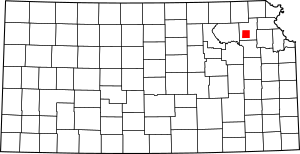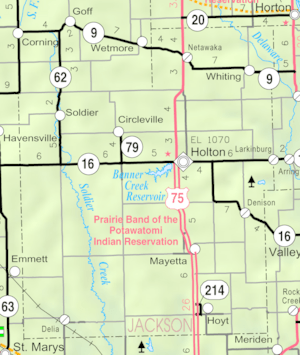Prairie Band Potawatomi Indian Reservation facts for kids
Quick facts for kids
Prairie Band Potawatomi Indian Reservation
|
|
|---|---|

Location of Reservation within Kansas
|
|

|
|
| Country | United States |
| State | Kansas |
| County | Jackson |
| Settled | 1837-1846 |
| Area | |
| • Total | 121.527 sq mi (314.754 km2) |
| • Land | 121.429 sq mi (314.501 km2) |
| • Water | 0.098 sq mi (0.253 km2) 0.08% |
| Population
(2000)
|
|
| • Total | 1,238 |
| • Density | 10.187/sq mi (3.9332/km2) |
| Time zone | UTC−6 (CST) |
| • Summer (DST) | UTC−5 (CDT) |
| Area code | 785 |
The Prairie Band Potawatomi Indian Reservation is a special area of land set aside for the Prairie Band Potawatomi Nation. It is located in Jackson County, Kansas, in the United States. This reservation is where the Potawatomi people live and govern themselves.
The Potawatomi people originally lived near the Great Lakes region. However, as more Europeans settled in their traditional lands, the Potawatomi were forced to move west. This move was part of a larger historical event where many Native American tribes were relocated.
The reservation covers all of Lincoln Township. It also includes parts of Banner Township, Franklin Township, and Grant Township.
Contents
History of the Potawatomi People
The Potawatomi are an Anishinaabe-speaking Native American tribe. Their name means "Keepers of the Fire." They were part of a large alliance called the Council of Three Fires. This alliance included the Ojibwe and Odawa tribes.
Early Life and Homeland
For many centuries, the Potawatomi lived in the Great Lakes area. This region includes parts of what are now the states of Michigan, Wisconsin, Illinois, Indiana, and Ohio. They had a rich culture based on hunting, fishing, and farming. They also traded with other tribes.
Forced Relocation West
In the 1800s, the United States government began a policy of moving Native American tribes. This was often done through treaties that were not always fair. The Potawatomi were among the many tribes forced to leave their ancestral lands. They were moved to different areas, including Kansas.
The journey was very difficult for the Potawatomi people. Many suffered from hunger, disease, and hardship. This forced movement is a sad part of American history. It shows how Native American tribes lost their homes and way of life.
Life on the Reservation Today
The Prairie Band Potawatomi Indian Reservation is a vibrant community. It is a place where the Potawatomi people can preserve their culture and traditions. They also work to build a strong future for their members.
Self-Governance and Community
The reservation is governed by the Tribal Council. This council makes decisions for the community. It manages services like education, healthcare, and public safety. This self-governance allows the tribe to control its own destiny.
The Tribal Council works to improve life for everyone on the reservation. They focus on economic development and cultural programs. These efforts help keep Potawatomi traditions alive for younger generations.
Culture and Traditions
The Potawatomi people are proud of their heritage. They work hard to teach their language and customs to children. Cultural events and ceremonies are important parts of life on the reservation. These events help connect people to their past.
The tribe also runs businesses that help support the community. These businesses create jobs and bring money to the reservation. This helps the tribe become more self-sufficient.
Geography and Location
The Prairie Band Potawatomi Indian Reservation is located in northeastern Kansas. It is about 30 miles north of Topeka, the state capital. The land is mostly flat or gently rolling. It is typical of the prairie landscape of Kansas.
Size and Area
The reservation covers a total area of about 121.5 square miles (314.7 square kilometers). Most of this land is dry land, with a small amount of water. This makes it a significant area within Jackson County.
Surrounding Areas
The reservation is surrounded by other parts of Jackson County. It is an important part of the local geography. The people living on the reservation are part of the larger community of Kansas.

